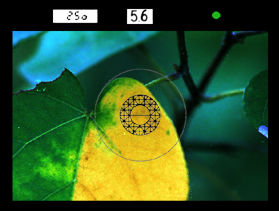The first phase of the autofocus evolution during the mid-eighties has forced Nikon to introduce a series of AF Nikkor lenses to supplement the early AF bodies of F-501(1986), F-401 (1987) and F-801/Nikon F4 later in 1988 (Although the first batch of AF-Nikkor 80mm f/2.8 and AF-Nikkor 200mm f/3.5 EDIF introduced in 1983 were more specifically designed for the Nikon F3AF SLR camera), the TWO dedicated early F3AF-Nikkor lenses have a different appearance and exterior cosmetic from Nikkor lens models introduced at the later stages. Now, will the previously featured Ai Micro-Nikkor lenses fit to be used used with earlier non-Ai Nikon SLR bodies ? and how about the AF Micro-Nikkor introduced later ? Yes. All MF Micro-Nikkor can be used with non-Ai bodies except they are only confined to operate in stopped down metering but full aperture viewing/focusing is still possible.
Well, that is NOT the case with AF Micro-Nikkor lenses. Although all Nikon AF are basically came with Ai-S specifications but they have one problem in their backward compatibility with older non-Ai Nikon SLR cameras, i.e. AF Nikkor lenses do not have a meter coupling shoe on the aperture ring. The omission of the tiny feature which is essential to couple with the camera's meter with prisms of non-Ai Nikon F, F2 and the body integrated metering found on Nikkormat camera bodies means AF range of Micro-Nikkor lenses are NOT advisable to used with any of those Nikon SLR camera models. Although, technically, all AF Nikkor lenses can still be mounted on to them while minus the metering capability but Nikon advises such attempts may damage the lens. So, I would rather you follow the advice instead of trying to be a hero.
 |
W A R N I N G: For other non-Ai Nikon SLRs such as the Nikkormat, the protruding meter coupling pin is used to mate with the Meter Coupling shoe on the lens. The removal of that feature indirectly means older Nikkor bodies cannot be used with newer AF lenses. The Nikon Series-E lenses introduced along with Nikon EM were the ONLY manual focus lenses from Nikon that do not provide with a Meter coupling shoe on the lens. these lenses are also NOT usable with Non-Ai Nikon Bodies. |
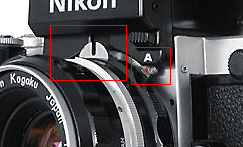 |
|
Nikon F2 series models and Nikkormat bodies comprised a mixture of AI and non-Ai metered prisms/body and thus NOT ALL F2 models and/or Nikkornats can used AF Nikkor lenses ! Note: Nikon F2A, Nikon F2AS, Nikkormat FT3 and Nikon EL-2 are Ai-bodies. Also please note the omission of the meter coupling shoe on a typical AF Nikkor lens. |
Strangely, it looked more like a commercial decision rather than from a technical point of view for not able to add the meter shoe on subsequent AF Nikkor lenses introduced as both the earlier F3 AF lenses have such considerate feature built-in to them. (see below, image of an AF Nikkor 80mm f/2.8 at far left).
 |
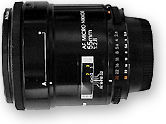 |
The first generation AF Micro-Nikkor lens was still retaining similar 55mm focal length instead the current 60mm and both series have omitted the Meter Coupling Shoe on the aperture ring. |
The removal of the meter coupling shoe on the aperture ring means the AF-Nikkor lenses will no longer be supporting older non-Ai Nikon SLR bodies. Complaint ? Yea. Well, personally, I really wondering why was it so difficult for Nikon design team to come out with an acceptable exterior finishing for the first generation of AF-Nikkor lenses. The AF-Nikkor lenses for the F3AF have a far superior built quality and exterior finishing which was heavily missed in the early AF-Nikkor lenses introduced along with the F-501 & F-401 era. It took almost 3 years before Nikon finally revised their design again and improved some areas such as the stupidly designed narrow rubberized hand grip for manual focusing. Well, not entirely convinced was - they did a good job as at later stage, the focusing grip has been extended and widen a little but overall, I thought AF-Nikkor lenses can still be improved in their exterior appearance. In this respect, I think Canon and even the Pentax did a more commendable job than Nikon.
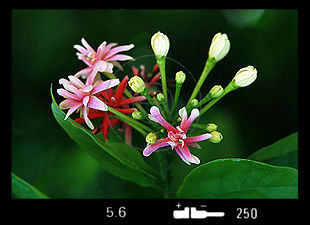 |
<<< --- With a macro lens, everything around you - such as your backyard or in your garden can be an excellent location to explore the macro world of photography as these close focus lenses are very versatile to act both as a dedicated close-up optic or just as a normal standard or telephoto lens. The Micro-Nikkor series lenses have long been known for their exceptional optical performance. It worth to serious consider to invest into one of these series of lenses, even for general photography. |
WARNING: Before proceeding to discuss further with other newer series of AF Micro-Nikkor lenses that followed, I think you should really pay some attention here: If you are still unsure whether what are the differences between an Ai or non-Ai Nikon camera/lenses, then I would rather suggest you to skip this section of the AF Micro-Nikkor lenses. The best bet is to go for the manual focus Ai version of the Micro-Nikkor lenses to minimize chances of incompatibilities in any possible combinations. For those who is curious enough to find out more about the differences - Click Here !
You can use the listings below serve as a guideline to see how the various Micro-Nikkor lenses evolved over the years. To me, one important aspect of the Micro-Nikkor lenses is - right from the original lenses at 50mm focal length, the micro-Nikkor lens group has developed into a very comprehensive system comprised of various lens types, size, weight, lens speed, magnification ratio, working distance and even with their respective prices as well. Some very specialized lenses such as the older Bellow-Nikkor, Medical-Nikkor lenses or the newer breed close-up lenses such as PC-Micro-Nikkor or the Zoom-Micro-Nikkor lenses can be considered as new breed of variations of close-up lenses that branch-out and evolved from the original Micro-Nikkor lens family.
 |
1956 RF Micro-Nikkor 5cm f/3.5 5 elements in 4 groups |
Although technically, you NEED NOT have to use a specialized close-up lens such as any of these superb range of Micro Nikkor lenses for shooting macrophotography as there are a few other cheaper alternatives to obtain similar results. More economical ways such as attaching an close-up accessories between any normal Nikkor lens in order to help getting focuses close than physically a lens permits. The cheapest way is to use close-up filters which is used by Snap-On to the front of the lens in use. Accessories used between camera and lens has far greater magnification ratio, examples are bellow units, extension tubes or even use a reversal ring.
Copyright ©-free Images collection. 2001, leofoo (38 K Jpeg) Malaysian Internet Resources
Anyway, it takes a great deal to discuss the enormous possibilities of how to make good use of Micro-Nikkor lenses. It can also be quite confusing at times, especially to understand issues such compatibility involving versions between applicable lenses and camera models. However, that was essentially relates to stages of evolution in both Nikon camera and Nikkor lenses and such potential operational problems was not just only confined to the Company Nikon alone as users of other major 35mm photographic systems such as Canon, Minolta etc. do faced similar issues at in the path of migration of their respective lens mount to newer versions. Well an easier way to advice you what to do with this is, If you are using an AF Nikon SLR camera, just buy the latest version of the AF Nikkor lens type - that saves a lot of trouble and should provide you with the best of handling ease and compatibility. But if you are seasoned and knowledgeable enough able to distinguish the differences amidst all the changes that have happened since the first Micro-Nikkor (and Nikon cameras too) was introduced - you could possible save a lot of money to invest into one of those older series MF lenses.
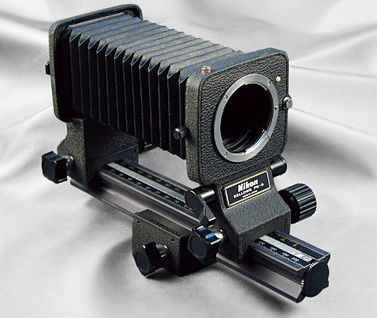 |
Whatever it is, pages that followed provide a brief guide with all possible variations and available options that best suit your individual budget and requirement for your personal macrophotography within the Micro-Nikkor lens family. Content writings on respective optic is entirely personal and they are solely served for reference and should NOT be used as an absolute buying guide or influence any individual buying decision (As I feel very pressurize with it....). |
| Previous | Index Page - Micro-Nikkor Lenses 3/3
Micro-Nikkor
lense Family:
| 50mm | 55mm (AF) | 60mm
(AF)
| 85mm
PC
| MF-105mm (AF) | MF-200mm (AF) | 70-180mm
(AF)
|
| Back | Main Index Page
of Nikkor Resources
Personal Note: The Manual focus Nikon F2 and Nikon F3 represent two different generations with entire mechanical control to semi-automatic operation. The problem is, I did the Nikon F3 site first before I reverted back to take a look at Nikon F2 and did quite a comprehensive write-up on macrophotography to patch what is heavily missing in the Nikon F3 section on close-up photography. Because each of the F-series SLR bodies has a macrophotography section. You may also make use of them to refer the various stages of development for Nikon close-up photographic system, of particular interest is the older system close-up accessories. | Macro with Nikon F2 (11 parts) | Macro with Nikon F3 (3 parts) | Macro with Nikon F4/F5 (new)
| Message Board |
for
your Nikkor
Optics
in a shared environment
| Message
Board
| Specifically for Dispose or Looking for new/used Nikon/Nikkor
photographic equipment
| Nippon Kogaku Rangefinder Resources | Nikon F | Nikon F2 | Nikon F3 | Nikon F4 | Nikon F5 | Nikon F6 | Nikkormat / Nikomat | Nikon FM Series | Nikon FE/ FA | Nikon EM/FG/FG20 | Nikon Digital SLRs | Nikon - Other models |
Nikon MF RF-Nikkor lenses for Rangefinder
cameras:-
Main Index Page
Nikon
Auto Focus Nikkor lenses:- Main
Index Page
Nikon
Manual
Focus
Nikkor lenses:-
Fisheye-Nikkor Lenses - Circular |
Full Frame |
Ultrawides Lenses - 13mm15mm18mm20mm |
Wideangle Lenses - 24mm28mm35mm |
Standard Lenses - 45mm 50mm 58mm | Telephoto Lenses
- 85mm105mm135mm180mm & 200mm |
Super-Telephoto Lenses - 300mm 400mm 500mm 600mm 800mm 1200mm |
 |
Special Application
lenses: Micro-Nikkor Lenses - 50mm~55mm -60mm 85mm -105mm 200mm Micro-Zoom 70-180mm Perspective Control (PC) - 28mm 35mm PC-Micro 85mm Dedicated Lenses for Nikon F3AF: AF 80mm f/2.8 | AF 200mm f/3.5 EDIF Depth of Field Control (DC): 105mm 135mm Medical Nikkor: 120mm 200mm Reflex-Nikkor Lenses - 500mm 1000mm 2000mm Others: Noct Nikkor | OP-Nikkor | UV Nikkor 55mm 105mm | Focusing Units | Bellows-Nikkor 105mm 135mm Nikon Series E Lenses: 28mm35mm50mm100mm135mm | E-Series Zoom lenses: 36~72mm75~150mm70~210mm |
MF Zoom-Nikkor Lenses: 25~50mm | 28~45mm | 28~50mm | 28~85mm | 35~70mm | 36~72mm E | 35~85mm | 35~105mm | 35~135mm | 35~200mm | 43~86mm | 50~135mm | 50~300mm | 70~210mm E | 75~150mm E | 80~200mm | 85~250mm | 100~300mm | 180~600mm | 200~400mm | 200~600mm | 360~1200mm | 1200~1700mm
Tele-Converters: TC-1 | TC-2 | TC-200 | TC-201 | TC-300 | TC-301 | TC-14 | TC-14A | TC-14B | TC-14C | TC-14E | TC-16 | TC-16A | TC-20E
Recommended links to understand more technical details
related to the Nikkor F-mount and production Serial Number:
http://rick_oleson.tripod.com/index-153.html by: my
friend, Rick Oleson
http://www.zi.ku.dk/personal/lhhansen/photo/fmount.htm by: Hansen,
Lars Holst
http://www.mir.com.my/rb/photography/hardwares/nikonfmount/lens2.htm
http://www.photosynthesis.co.nz/nikon/serialno.html
Recommended Reading Reference on Nikon cameras and Nikkor lenses | about this photographic web site
| | Back | Main Index Page of Nikkor Resources | Back | Main Index Page of Pictorial History of Nikon SLRs |
| Home - Photography in Malaysia |
![]() Co-developed
with my web buddy, Rick Oleson® &
Co-developed
with my web buddy, Rick Oleson® & ![]() Denmark, Creator of the Nikon
Repair Group Mailing-List;
A
contributing effort to Michael Liu's Classic Nikon SLRs and
Nikkor optic site.
Denmark, Creator of the Nikon
Repair Group Mailing-List;
A
contributing effort to Michael Liu's Classic Nikon SLRs and
Nikkor optic site.
Credit: MCLau®, who has helped to rewrite
some of the content appeared this site. Chuck Hester® who has been helping
me all along with the development of all these Nikon websites; Lars Holst Hansen, 'Hawkeye'
who shares the same passion I have; Ms Rissa, Sales manager
from Nikon Corporation Malaysia for granting permission to use some of the official
content; Ted Wengelaar, Holland
who
has helped to provide many useful input relating to older Nikkor lenses; Some of the references
on production serial numbers used in this site were extracted from Roland Vink's website; Hiura Shinsaku from Nikomat
Club Japan. Lastly,
to all the good people who has contributed their own expeience, resources or kind
enough granted permission to use their images of their respective optic in this site.
It is also a site to remember a long
lost friend
on the Net. Note:certain content and
images appeared in this site were either scanned from official marketing leaflets
& brochures published by Nikon and/or contribution from surfers who claimed originality
of their work for educational purposes. The creator of the site will not be responsible
for may discrepancies arise from such dispute except rectifying them after verification. "Nikon", "Nikkormat", "Nippon Kokagu
KK"
& "Nikkor" are registered
tradename of Nikon Corporation Inc., Japan. Site made with an Apple IMac.

